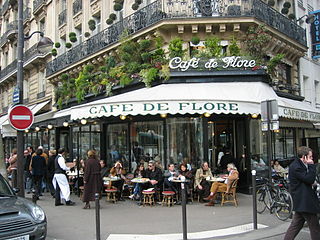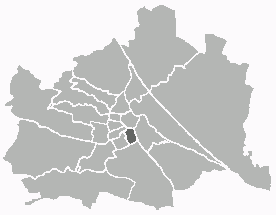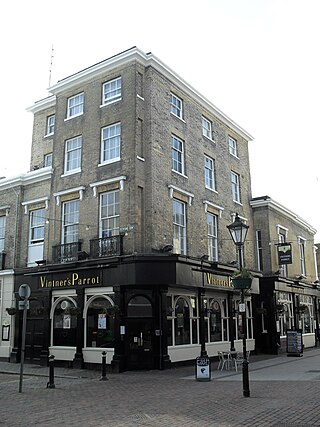
Vienna is the capital, largest city, and one of nine provinces of Austria. Vienna is Austria's most populous city and its primate city, with about two million inhabitants, and its cultural, economic, and political center. It is the 6th-largest city proper by population in the European Union and the largest of all cities on the Danube river.

Viennese waltz is a genre of ballroom dance. At least four different meanings are recognized. In the historically first sense, the name may refer to several versions of the waltz, including the earliest waltzes done in ballroom dancing, danced to the music of Viennese waltz.

St. Stephen's Cathedral is the mother church of the Roman Catholic Archdiocese of Vienna and the seat of the Archbishop of Vienna, Christoph Cardinal Schönborn, OP. The current Romanesque and Gothic form of the cathedral, seen today in the Stephansplatz, was largely initiated by Duke Rudolf IV (1339–1365) and stands on the ruins of two earlier churches, the first a parish church consecrated in 1147. The most important religious building in Vienna, St. Stephen's Cathedral has borne witness to many important events in Habsburg and Austrian history and has, with its multi-coloured tile roof, become one of the city's most recognizable symbols.

İstiklal Avenue historically known as the Grand Avenue of Pera, in the historic Beyoğlu (Pera) district, is an 1.4 kilometre (0.87 mi) pedestrian street and one of the most famous avenues in Istanbul, Turkey. It acquired its modern name after the declaration of the Republic on 29 October 1923, İstiklal (Independence) commemorating Turkey's triumph in its War of Independence.

A tavern is a type of business where people gather to drink alcoholic beverages and be served food such as different types of roast meats and cheese, and where travelers would receive lodging. An inn is a tavern that has a license to put up guests as lodgers. The word derives from the Latin taberna whose original meaning was a shed, workshop, stall, or pub.

A coffeehouse, coffee shop, or café is an establishment that primarily serves coffee of various types, notably espresso, latte, and cappuccino. Some coffeehouses may serve cold drinks, such as iced coffee and iced tea, as well as other non-caffeinated beverages. In continental Europe, cafés serve alcoholic drinks. A coffeehouse may also serve food, such as light snacks, sandwiches, muffins, fruit, or pastries. Coffeehouses range from owner-operated small businesses to large multinational corporations. Some coffeehouse chains operate on a franchise business model, with numerous branches across various countries around the world.

Meidling is the 12th district of Vienna. It is located just southwest of the central districts, south of the River Wien, west of the Gürtel belt, and east and southeast of Schönbrunn Palace. Meidling is a heavily populated urban area with many residential buildings, but also large recreational areas and parks. In sports, it is represented by the FC Dynamo Meidling. Former Chancellor of Austria Sebastian Kurz was born and raised in Meidling and his private residence is there.

Bryggen, also known as Tyskebryggen, is a series of Hanseatic heritage commercial buildings lining up the eastern side of the Vågen harbour in the city of Bergen, Norway. Bryggen has been on the UNESCO list for World Cultural Heritage sites since 1979.

Beyoğlu is a district on the European side of İstanbul, Turkey, separated from the old city by the Golden Horn. It was known as the region of Pera surrounding the ancient coastal town Galata which faced Constantinople across the Horn. Beyoğlu continued to be named Pera during the Middle Ages and, in western languages, into the early 20th century.

The Viennese coffee house is a typical institution of Vienna that played an important part in shaping Viennese culture.

Wieden is the 4th municipal district of Vienna, Austria. It is near the centre of Vienna and was established as a district in 1850, but its borders were changed later. Wieden is a small region near the city centre. After World War II, Wieden was part of the Soviet sector of Vienna for 10 years.

Levantine mansions of İzmir refer to about thirty stately residences in İzmir, Turkey, dating principally from the 19th century and of which a significant number remain intact by being restored and continuing to be used and visited.

The Augarten is a public park of 52.2 hectares situated in the Leopoldstadt, the second district of Vienna, Austria. It contains the city's oldest Baroque park.

Greeks in Austria number between 5,000 and 18,000 people. They are located all around the country, but the main community is located in Vienna.

Schnoor is a neighbourhood in the medieval centre of the German city of Bremen, and the only part of it that has preserved a medieval character. The neighbourhood owes its name to old handicrafts associated with shipping. The alleys between the houses were often associated with occupations or objects: There was an area in which ropes and cables were produced and a neighboring area, where wire cables and anchor chains were manufactured.

The Zunfthaus zur Haue or Haus zur Haue is situated at the Limmatquai promenade between Münsterbrücke and Rathausbrücke. It is the guild house of the Zunft zum Kämbel, meaning the guild of the merchants and traders. Neighbored by the Saffran, Zimmerleuten, and Rüden guild houses, it is one of the historically notable buildings in Zürich, Switzerland. The building also houses the relatively expensive restaurant of the same name.

The Thieves' Kitchen is a pub in the centre of the town and borough of Worthing, West Sussex. Established as a public house in the late 20th century, it occupies two early 19th-century listed buildings in the oldest part of the town: a Greek Revival-style former wine merchants premises, and a Neoclassical chapel built for Wesleyan Methodists in 1839. The main part of the pub is in the wine merchants building facing Warwick Street, while the old chapel, facing Bedford Row, serves as its function room. Both buildings have been designated separately as Grade II Listed Buildings.
Levantines in Turkey or Turkish Levantines, refers to the descendants of Europeans who settled in the coastal cities of the Ottoman Empire to trade, especially after the Tanzimat era. Their estimated population today is around 1,000. They mainly reside in Istanbul, İzmir and Mersin. Anatolian Muslims called Levantines Frenk and tatlısu Frengi in addition to Levanten.

Weinplatz is a popular public square adjacent to the Gmüesbrugg bridge and the historical Schipfe quarter.


















